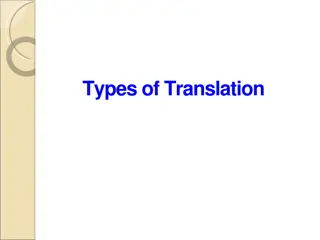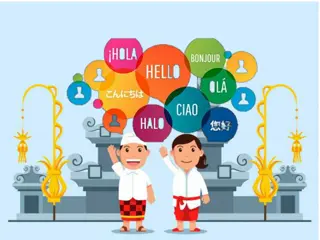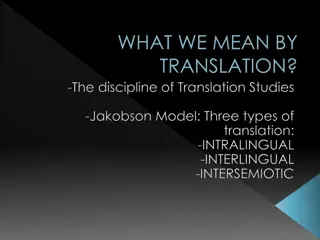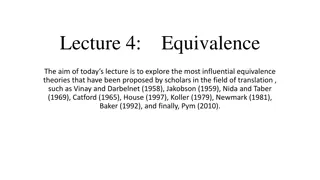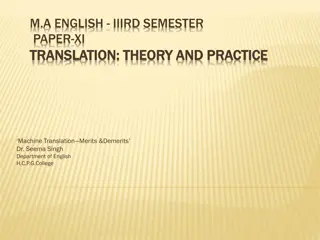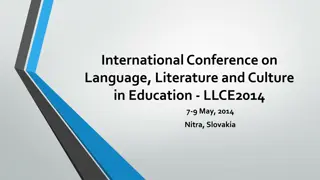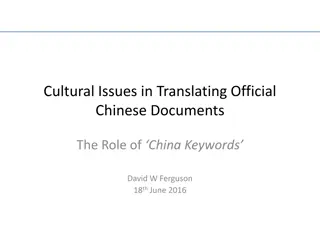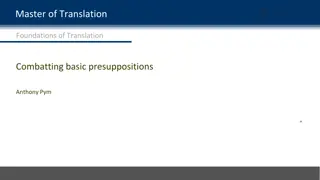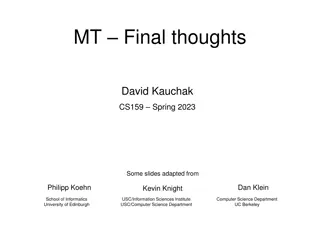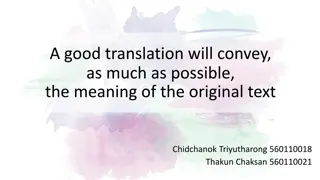Understanding Translation Studies: From Origins to Cultural Turn
The exploration of translation studies, from its historical roots to the modern cultural turn, delves into the essence of translation, its typologies according to Jakobson, the role of translators through historical perspectives from Cicero to modern times, and insights from Dryden and Schleiermacher. The discussion covers the challenges of achieving equivalence and the importance of adapting text meaning rather than literal words. It sheds light on the evolution of translation theory and its impact on cultural understanding.
Download Presentation

Please find below an Image/Link to download the presentation.
The content on the website is provided AS IS for your information and personal use only. It may not be sold, licensed, or shared on other websites without obtaining consent from the author. Download presentation by click this link. If you encounter any issues during the download, it is possible that the publisher has removed the file from their server.
E N D
Presentation Transcript
The Cultural Turn in Translation Studies Prof.ssa Laura Anelli Universit Cattolica del Sacro Cuore di Milano
Outline 1) What is translation? 2) Translation from its origins to Translation Studies 3) Descriptive Translation Studies 4) Polysystem Theory Itamar Even-Zohar 5) The Manipulation School 6) The cultural turn 7) For a definition of culture 8) The challenges of translation
What is translation? The term translation can refer to: The finished product The process of translating For most people it means a transposition of words meaning from a language into another
Jakobson On Linguistic Aspects of Translation (1959) He identifies three typologies of translation: Intralingual translation or rewording is an interpretation of verbal signs by means of other signs in the same language : for example the translation of Harry Potter from BrE to AmE or the adaptation of classics for children; Interlingual translation or translation proper is an interpretation of verbal signs by means of some other language : a novel written into English and translated into Italian for example; Intersemiotic translation or transmutation is an interpretation of verbal signs by means of signs of nonverbal sign systems : a movie adaptation of a book for example.
What is the role of translation/the translator? According to the vast majority of people translation should aim to equivalence Cicero, De optimo genere oratorum (46 BC): a translator should behave not only as a translator (interpretes) but also as a writer (orator) respecting sentences, words and thoughts of the source text but adapting it to Latin habits Horace, Ars Poetica (10 BC): the poet who resorts to translation should avoid word-for-word rendering and write distinctive poetry Jerome, Bible translation, Letter to Pammachius (395 AD), underlines the importance of translating not word for word but sense for sense
Dryden, Scheilermacher Dryden (1631-1700) classifies three types of translation Metaphrase, word-for-word Paraphrase, the focus is on the author of the source text and the meaning Imitation, a sort of free translation for the sake of the target audience s needs Schleiermacher, On the Different Methods of Translating (1813) Translation can bring the reader to the writer Translation can bring the writer to the reader This discussion continues about the role of translation continues today
Equivalence in difference According to Jakobson (1953): Languages differ essentially in what they must convey and not in what they may convey . Equivalence in difference is the cardinal problem of language and the pivotal concern of linguistics. Translation is always possible
But what is equivalence? Nida (1964): Formal equivalence focuses the attention on the message itself, in both form and content Dynamic equivalence aims at complete naturalness of expression and tries to relate the receptor to modes of behaviour relevant within the context of his own culture
The study of translation For a long time translation studied by: Linguistics Comparative literature Translators Pivotal year: 1972 Third Congress on Applied Linguistics Copenhagen
A new discipline: Translation Studies J.S.Holmes, The Name and Nature of Translation Studies Translation Studies Three branches: 1) Descriptive Translation Studies (DTS) 2) Theoretical Translation Studies (ThTS) 3) Applied Translation Studies (ATS)
Descriptive Translation Studies They aim to describe the phenomena of translating and translation(s) as they manifest themselves in the world of our experience (Holmes 1972:71) They can be: - product-oriented, - function-oriented, - process-oriented.
Theoretical Translation Studies Their aim is to establish the general principles by means of which these phenomena [of translation] can be explained and predicted (Holmes 1972:71)
Applied Translation Studies They deal with: Translation teaching Translation criticism Translators training
The Polysystem Theory Itamar Even-Zohar (1978) The literary system is seen as a complex polysystem (a dynamic system) formed by smaller systems (he moves from Russian Formalists and Structuralists) These systems compete one against the others: some systems are pushed towards the centre; others are pushed towards the periphery. Normally translations had been considered a minor literary form periphery
The Polysystem Theory (2) Translation is now pushed towards the centre of the polysystem because it can bring innovation, establish canons, This is especially true for young literary systems Translation has the power to renovate, enrich, widen the receiving language, literature and culture (Nergaard 1993:18) Double nature of the translated text: it is a rendering of a source text but also each translation is a creation and thus constitutes a unique text (Paz 1992:154) Translation affects receiving cultural systems
Cultural Systems cultures are changeable in principle, [and] given the time, [also] every single cultural system would indeed undergo some change (Toury 2005:3) Translation can be subversive, innovatory or radical (Bassnett 1996:13) it can modify and shape the receiving culture
The Manipulation School Hermans, 1985, The Manipulation of Literature: Studies in Literay Translation - Theo Hermans - Gideon Toury - Susan Bassnett - Andr Lefevere
The Manipulation School (2) Every translation is a manipulation of the source text due to some external factors such as: Historical period Who commissioned the translation and for which reasons Socio-cultural context Receiving culture (Lefevere 1992:viii)
The receiving cultural system When analysing a translation, it is important to consider not only the linguistic factors but also the receiving cultural system This can influence not only how texts are translated but also which texts are translated
The Cultural Turn in Translation Studies The studies of the Manipulation School scholars are part of the so-called cultural turn in Translation Studies The Translation Turn in Cultural Studies a paper by Susan Bassnett (Bassnett/Lefevere 1998:123) When analysing a translation it is important to understand its context
Context of Situation and Context of Culture It is clear the importance of context: Context of situation: the environment in which the text comes to life (Halliday 1993:265) Tenor: participants in a conversation and their relationship Field : what the conversation is about Mode: the role played by the language The context of situation is inserted in the broader context of culture
Context of culture Malinowski (1923) the way of life of a society Culture is: The arts and other manifestations of human intellectual achievement regarded collectively. (OED) Culture The ideas, customs, and social behaviour of a particular people or society - culture
Translation Studies and Cultural studies Two important scholars: Andr Lefevere - rewriting Lawrence Venuti domestication / foreignization
Andr Lefevere Translation, Rewriting and the Manipulation of Literary Fame (1992) Every translation is a form of manipulation of the text and it is called rewriting Examples of rewriting include interlingual translation, movie adaptations, anthologies, Rewriting is controlled by two factors: Specialist (internal) Patronage (external)
Specialists and Patronage Specialists are all the people that are directly involved with texts (translators, critics, ) Patronage is embodied in institutions (such as government, ministries, publishing houses, ) and it is composed of three parts: Social Economic Ideological
Lawrence Venuti The Translator s Invisibility: A History of Translation (1995) Translators are not given enough credit, they are invisible due to the normal tendency to translate text in a way which is more acceptable to the receiving culture Domestication vs foreignization (see Schleiermacher)
Implications for translation If translation is a bridge between two languages and two cultures, the context of culture must be taken into account while translating: Source Language Target Language Source Culture Target Culture Translators are required competence also in cultural knowledge knowing a language is not enough
Practical implications Textual genre (for example letters) Culture-bound items (i.e. items belonging to one culture that may be not so well known in the receiving culture) Intertextual references (references to Culture) Target audience (children, adults, ) Aim of the text (education, entertainment, ) .
Text one The Things They Carried Tim O Brien First Lieutenant Jimmy Cross carried letters from a girl named Martha, a junior at Mount Sebastian College in New Jersey. They were not love letters, but Lieutenant Cross was hoping, so he kept them folded in plastic at the bottom of his rucksack. In the late afternoon, after a day s march, he would dig his foxhole, wash his hands under a canteen, unwrap the letters, hold them with the tips of his fingers, and spend the last hour of light pretending. He would imagine romantic camping trips into the White Mountains in New Hampshire. He would sometimes taste the envelope flaps, knowing her tongue had been there. More than anything, he wanted Martha to love him as he loved her, but the letters were mostly chatty, elusive on the matter of love. [ ] she wrote beautifully about her professors and roommates and midterm exams, about her respect for Chaucer and her great affection for Virginia Woolf. She often quoted lines of poetry; she never mentioned the war, except to say, Jimmy, take care of yourself. The letters weighed ten ounces. They were signed Love, Martha, but Lieutenant Cross understood that Love was only a way of signing and did not mean what he sometimes pretended it meant. [ ]
Analysis The Things They Carried Tim O Brien First Lieutenant Jimmy Cross carried letters from a girl named Martha, a junior at Mount Sebastian College in New Jersey. They were not love letters, but Lieutenant Cross was hoping, so he kept them folded in plastic at the bottom of his rucksack. In the late afternoon, after a day s march, he would dig his foxhole, wash his hands under a canteen, unwrap the letters, hold them with the tips of his fingers, and spend the last hour of light pretending. He would imagine romantic camping trips into the White Mountains in New Hampshire. He would sometimes taste the envelope flaps, knowing her tongue had been there. More than anything, he wanted Martha to love him as he loved her, but the letters were mostly chatty, elusive on the matter of love. [ ] she wrote beautifully about her professors and roommates and midterm exams, about her respect for Chaucer and her great affection for Virginia Woolf. She often quoted lines of poetry; she never mentioned the war, except to say, Jimmy, take care of yourself. The letters weighed ten ounces. They were signed Love, Martha, but Lieutenant Cross understood that Love was only a way of signing and did not mean what he sometimes pretended it meant. [ ]
Text two The Evolution of Bruno Littlemore Benjamin Hale There followed another couple of weeks of busy preparations for our imminent departure. I understood so little of what was going on. I was not well traveled. Chicago was the only home I had ever known. I was born in it. I had never been outside its city limits. There were only three places in the world that I knew well: (one) the Primate House at the Lincoln Park Zoo; (two) the main campus of the University of Chicago in general and room 308 of the Erman Biology Center in particular; and (three) the interior of 5120 South Ellis Avenue, Apartment 1A, Chicago, Illinois. Now we were about to leave this place, the place that then constituted all the known world to me, and resettle in a place that was entirely alien to me, that was only a not even a concept! but just a word, a single meaningless word: Colorado. [ ] We would have to say good-bye to our urban existence. We would say good-bye to the magisterial ivy-strangled gray stone buildings of the University of Chicago. Good-bye to the crushing crowds, the bleating cars, the thundering trains that shook us in the night. Good-bye to the mannequins at Marshall Field s, good-bye to the scientists at the lab, good-bye to Haywood, good- bye to Mr. Morgan, with his parrots, his bagpipes, his backgammon, and his boiling beans. Good-bye to everything I had ever known.
Analysis The Evolution of Bruno Littlemore Benjamin Hale There followed another couple of weeks of busy preparations for our imminent departure. I understood so little of what was going on. I was not well traveled. Chicago was the only home I had ever known. I was born in it. I had never been outside its city limits. There were only three places in the world that I knew well: (one) the Primate House at the Lincoln Park Zoo; (two) the main campus of the University of Chicago in general and room 308 of the Erman Biology Center in particular; and (three) the interior of 5120 South Ellis Avenue, Apartment 1A, Chicago, Illinois. Now we were about to leave this place, the place that then constituted all the known world to me, and resettle in a place that was entirely alien to me, that was only a not even a concept! but just a word, a single meaningless word: Colorado. [ ] We would have to say good-bye to our urban existence. We would say good-bye to the magisterial ivy-strangled gray stone buildings of the University of Chicago. Good-bye to the crushing crowds, the bleating cars, the thundering trains that shook us in the night. Good-bye to the mannequins at Marshall Field s, good-bye to the scientists at the lab, good-bye to Haywood, good- bye to Mr. Morgan, with his parrots, his bagpipes, his backgammon, and his boiling beans. Good-bye to everything I had ever known.
The importance of time These two texts wouldn t be translated in the same way in two different moments: cultures change and modify as time passes by. The diachronic perspective is important in DTS.
Some translation practice Now try and translate the texts. We ll discuss about your translations and your choices.
Question time Do you have any questions?
References Agorni, Mirella (a cura di) 2005. La traduzione: teorie e metodologie a confronto. Milano: LED Bassnett, Susan/ Lefevere, Andr 1998. Constructing Cultures: Essays on Literary Translation. Clevedon: Multilingual Matters. Eco, Umberto 2003. Dire quasi la stessa cosa. Esperienze di traduzione. Milano: Bompiani. Halliday, MichealA. K. 1993(1975). Language as Social Semiotic. In Angermuller, Johannes/Mainguenau, Dominique / Wodak, Ruth (eds.) 2014. The Discourse Studies Reader. Main currents in theory and analysis. Amsterdam-Philadelphia: John Benjamins Publishing, pp. 263-271 (first published in Language and Literacy. ed. by Janet Maybin, 23-43, Clevedon:Open University) Holmes, James S. 1972. The Name and Nature of Translation Studies . In Holmes J.S. 1988. Translated! Papers on Literary Translation and Translation Studies. Amsterdam: Rodopi. Jakobson, Roman 1966. Aspetti linguistici della traduzione . In L. Heilman (ed.), Saggi di linguistica generale. Milano: Feltrinelli. Lefevere, Andr 1992. Translation, Rewriting and the Manipulation of Literary Fame. London and New York: Routledge (trad. it. di S. Campanini 1998 Traduzione e riscrittura: la manipolazione della fama letteraria . Torino: UTET). Nergaard, Siri (a cura di) 1993. La teoria della traduzione nella storia. Milano: Bompiani Nida, Eugene A. 1965. Towards a Science of Translating: With Special Reference to Principles and Procedures Involved in Bible Translation. Leiden: E. J. Brill Venuti, Lawrence 1999. L invisibilit del traduttore. Una storia della traduzione. (trad. di M. Guglielmini, titolo originale dell opera The translator s Invisibility: A History of translation,). Roma: Armando Editore. Venuti, Lawrence (ed.) 2005. The translation studies reader. London-New York: Routledge.




